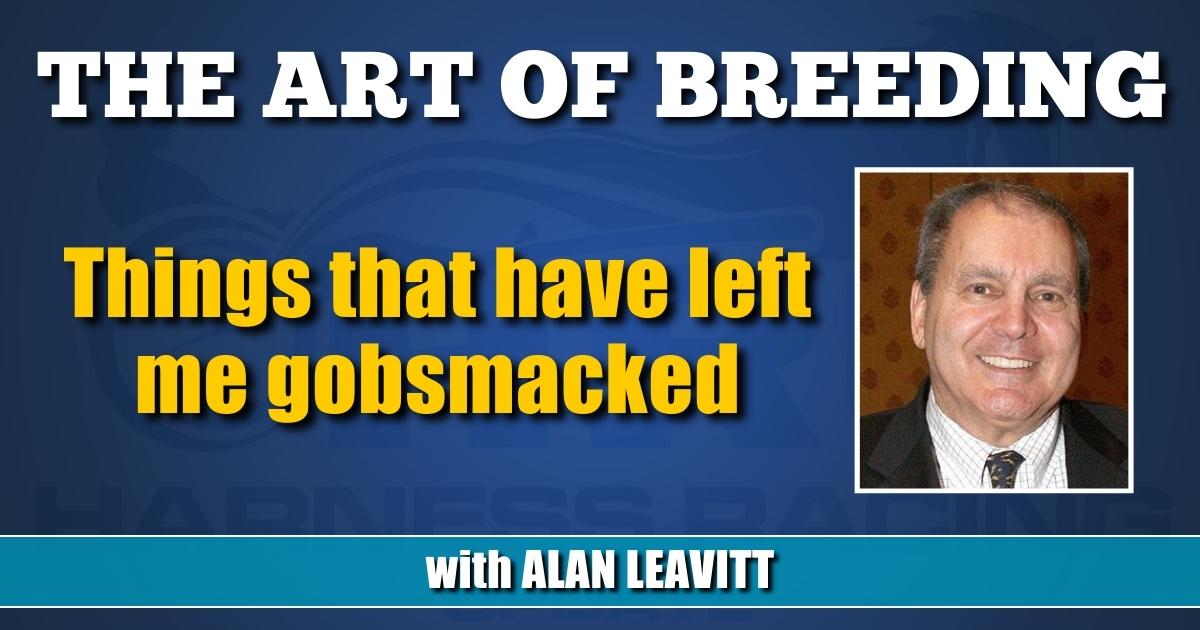Things that have left me gobsmacked
by Alan Leavitt
I continue to be gobsmacked by how many yearling videos are shot without white bell boots on in front. The boots do a great job of accentuating the yearling’s front action, and their weight is very helpful in keeping the horse on a fast trot.
Looking over the catalog for the forthcoming Lexington Yearling Sale, I continue to also be gobsmacked by the way the sale pedigrees are done. Why did they eliminate the sire paragraph?
The yearling’s sire is the single most important element in establishing a prospective buyer’s interest, and, if anything, enhancing his accomplishments can only enhance a yearling’s attractiveness.
On this subject, which to me is an important one, the thoroughbred business gets it right, in spades. Look at any Keeneland or Fasig-Tipton yearling catalog, and the first thing your eye lights on is the enhanced sire paragraph. In this respect, at least, the runners know what they’re doing a lot better than we do.
Speaking of the way the thoroughbreds do their pedigrees brings up the subject of having graded stakes, as they do, and our way, which is to do nothing. If you think in terms of trying to bring a thoroughbred racehorse owner into our business, the first thing he’ll balk at is the lack of graded stakes in our sales
pedigrees.
This is something that I’ve long fought for, starting from back in the days when Phil Langley was the USTA president. Langley was against grading our stakes because he thought it would offend the track owners whose stakes were rated lower than the track owners thought they should be.
The department at Fasig-Tipton that does the grading has offered to work with anyone the USTA sends to learn how grading works. They’ve also already come up with a special listing that would cover our sire stakes, which the runners don’t have.
Speaking of Langley, he and I came up together in our sport, more often than not on opposite sides of the same question. Langley was technically the employee of one Billy Johnston, who owned the tracks where Langley called most of the shots as racing secretary.
Johnston was not everybody’s cup of tea, and that included me. He did have a quick wit, as evidenced by his description of the name Breeders Crown as a great name for a brand of condoms. He and Langley both saw nothing wrong with one handed whipping, citing as support the fact that pro hockey was big on fist fighting.
When I responded that in pro hockey the participants all agreed to fight each other, while in harness racing whipping was inflicting pain upon innocent animals, they were unmoved. We went back and forth on this, and eventually I won out when the rule banning one handed whipping in Kentucky became the
norm throughout North America.
That, however, is of itself not enough to re-popularize our sport here in the United States. If there is an answer, it lies somewhere in the betting. If anyone has an answer, however, I believe it would be Dana Parham.
For 15 years, Parham was the head of a group that annually bet $50 million on harness races. Parham is not only a very smart guy, he’s an equally nice guy, and a pleasure to talk to. If anyone can come up with the kind of betting that would attract national interest in our sport, it’s Parham.
Surely, there must be one open-minded track operator out there who wants to take advantage of Parham’s vast betting knowledge.
This, again, brings up the god-awful track practice of “dragging,” or holding the field until after the official clock has hit zero. There are many reasons why this abominable practice is self-defeating, but there is one that is sufficient to kill it forever of itself, and that is it totally destroys the integrity of our sport.
Like a broken record, I again point out that in the biggest betting race in the world, the Kentucky Derby, when the clock at Churchill Downs is hitting zero, the horses are being loaded into the gate. Which makes this kid wonder, who are the people making the “dragging” decisions?
And now it’s time to answer the question of: What is the single most important thing to do when you’re riding or driving a horse?
The answer is: Keep the horse’s head straight.
Happy trails, everybody.
















